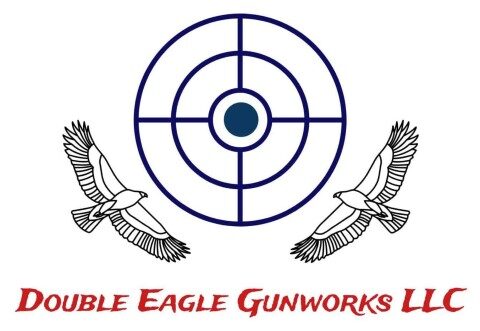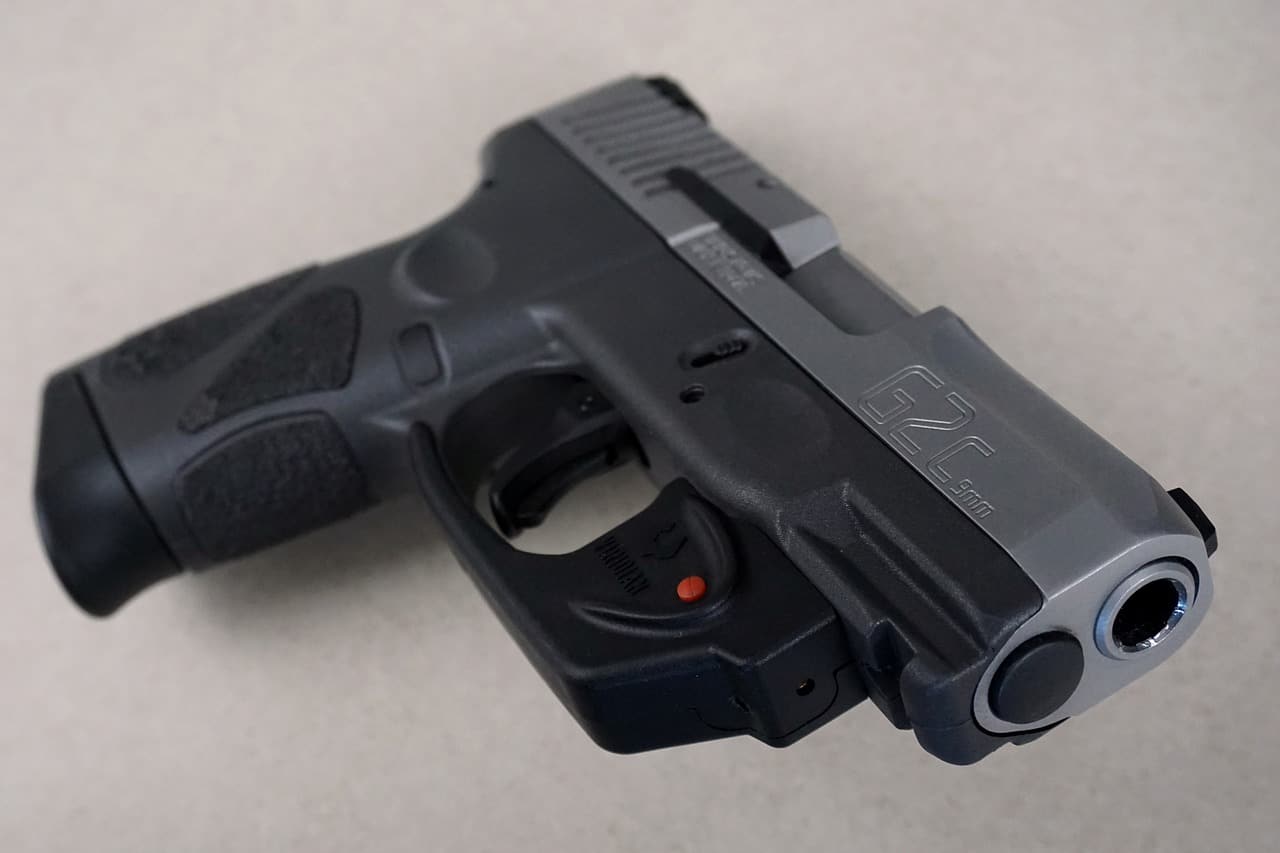Guns small enough to carry on your person are called handguns, or pistols, and they come in two types: the revolver and the semi-automatic.
Revolvers
The revolver is so named because of the cylinder that houses the bullets. You insert each round into a separate chamber of the cylinder, and then each one is revolved into position after its predecessor is fired. This is the gun you see most often in cartoons and old movies.
Revolvers in Popular Culture
The Lone Ranger, for instance, carried a Colt single action army revolver. Warner Brothers cartoon cowboy Yosemite Sam, the “rootinest, tootinest bobtailed wildcat north, south east or west of the Pecos,” carried two revolvers resembling .45s. Clint Easwood’s Dirty Harry carried a Smith and Wesson Model 29. The original Charlie’s Angels carried a variety of revolvers including the Smith and Wesson Bodyguard and the Colt Detective Special.
The Anatomy of a Revolver
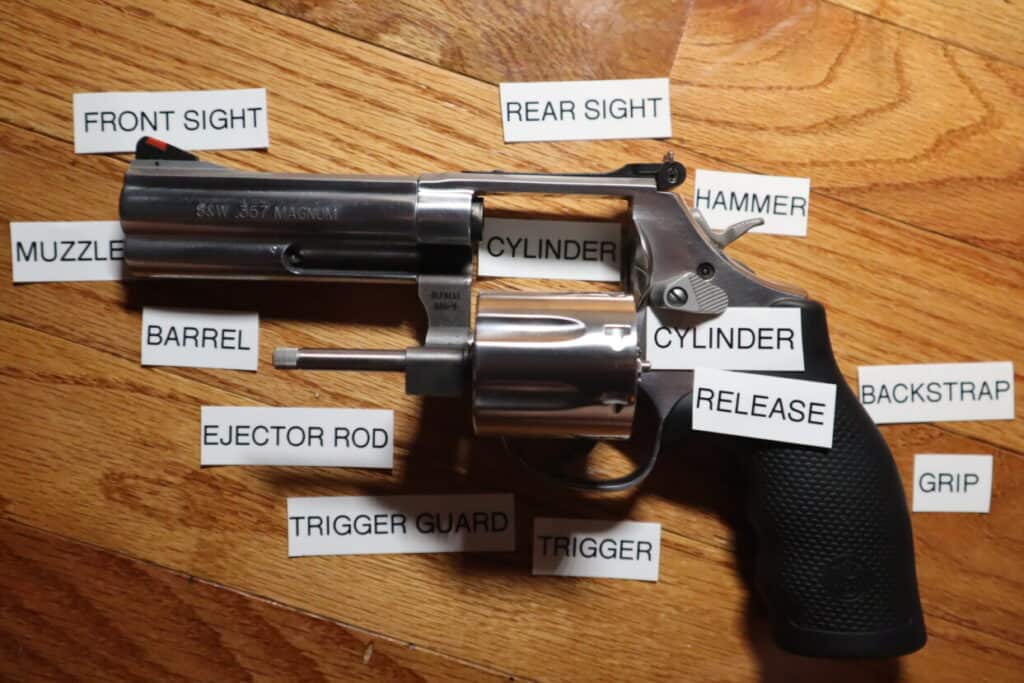
Cylinder
The revolver distinguishes itself from other guns with its cylinder, also called the wheel. This barrel shaped part is divided into individual chambers, each of which holds one round, also known as a cartridge.
You load the cylinder, bring it in line with the barrel, and then shoot. The next round moves into place automatically and you can keep shooting until you have spent all your ammunition.
The case remains in each chamber after the bullet has been shot.
Ejector Rod
After you shoot the bullets, you open the cylinder and remove the cases, either by tilting the gun to let gravity remove them or by pressing the rod that juts out from the front of the cylinder.
The star is on the other end of the cylinder and holds the cartridges in place until pushed forward by pressing the ejector rod. You can see just a hint of the star on the right of the cylinder in the photo above.
Barrel
This is where the bullet goes when you rotate the cylinder into place and squeeze the trigger.
Muzzle
The front part of the barrel where the bullet escapes is the muzzle. Good muzzle discipline is essential for safety. Don’t point the muzzle at anything you are not willing to destroy–including your feet.
Front and Rear Sights
When you look down the barrel of a gun you want to center the target between the rear sights, closest to your eyes, and the front sight, down at the other end. Gun connoisseurs will often opt to upgrade the sights with brighter colors, larger posts, or even lights and lasers to help with aim.
Cylinder Release
To the right of the cylinder and below the hammer in the photo above, the cylinder release must be pressed, pushed or pulled depending on the model of your gun. It keeps the cylinder clicked into place while shooting and then allows you to swing the cylinder out when you are ready to reload.
Hammer
This important part hits the firing pin, which activates the primer, causing the explosion of the powder charge in the cartridge, which shoots the gun. The primer is like the fuse on a firecracker.
The single action revolver requires the user to cock it manually. The double action revolver cocks the hammer automatically when you squeeze the trigger. The double action/single action revolver can be used either way.
Grip
The grip is the handle. You can customize the grip to a shape and width that suits your hand. Grips can be smooth or textured, and may have indentations that help you position each finger.
Backstrap
The backstrap is a part of the grip at the very back, where your palm rests.
Trigger Guard
In order to keep you from pulling the trigger accidentally, manufacturers provide a ring around the trigger. Keep your trigger finger along the barrel and out of the trigger guard until you are ready to shoot.
Trigger
This is where the fun happens. After you choose your target, aim your gun, and cock the hammer if necessary, you pull the trigger to activate the action that shoots the gun.
Trigger pull weight is a very important consideration when choosing your gun, and you will want to shoot a few rounds in the model you are considering to see whether your fingers can pull the trigger over and over.
Single or Double Action Revolvers
Revolvers can be classified as single action or double action. If pulling the trigger does one thing, activating the motion of the firing pin, that is single action.
Single Action Revolvers
To use a single action revolver you pull the hammer back by hand to rotate the cylinder before each shot. Then you pull the trigger to complete the action.
Single action revolvers come in all price points. I found the prices for this article at lipseys.com.
Note: prices reflect the situation when this article was written.
For under $250 MSRP you can get a North American Arms Mini-Revolver chambered in 22LR priced at $245.
This little gun with five chambers will conceal easily but won’t give you much stopping power. With a 1 1/8″ barrel, you wouldn’t want a bigger cartridge because small guns have more kick. This one weighs in at a slight 4.5 ounces.
In the $250 to $500 range you have the Ruger Wrangler 22LR for $329. With a 4.62″ barrel, this 6-shot revolver will have little kickback, making it more fun to shoot than its more powerful cousins. This is one my 10-year-old daughter particularly enjoys. It weighs 30 ounces.
In the $500 to $750 range you start seeing nicer finishes and better materials. The Ruger Blackhawk 45LC/45ACP has a 4 5/8″ barrel and shoots six bigger diameter .45 cartridges, with enough power to stop a large animal. This one weighs 39 ounces.
Move up to the $750+ range and you can get very nice guns indeed. The six-shot Colt Single Action Army .357 Magnum/.38 Special has a 4.75″ barrel and weighs 40 ounces, to provide a substantial mass that limits kickback.
Double Action Revolvers
If pulling the trigger also accomplished the movement of the hammer, it has done two things, making it double action. A double action revolver simply requires a pull of the trigger to shoot.
The low end of the MSRP with double action revolvers begins at the $250 to $500 range. You can get a Taurus Model 380 IB 380 ACP for $478.40. This five chambered revolver has a 1 3/4″ barrel and weighs 15.5 ounces. This size is ideal for concealed carry as it has a smaller profile without too much kick.
In the $500 to $750 range you can get a Taurus Judge Magnum Engraved .420 Bore/.45 Colt for $681.80. This one has extra flourishes engraved into the barrel and frame for a dash of elegance. It has a 3″ barrel, chambers 5 cartridges, and weighs 36.8 ounces.
Advancing to the $750 MSRP market gets you access to such beauties as the Colt King Cobra Carry .357 Magnum/.38 Special for $899.00. This one has a 2″ barrel and weighs 28 ounces because it has a steel frame. It chambers six rounds.
Internal Hammer Double Action Revolvers
Double action revolvers also have the option of an internal hammer. Rather than having the hammer accessible, these revolvers have it inside the case where it is actuated by the trigger pull.
This gives a more streamlined effect and keeps it from snagging your clothes when you draw it. The Smith and Wesson 442 .38 Special has an internal hammer and a 1 7/8″ barrel for $493.00. It weighs 14.8 ounces and comes with a pink or blue grip for the fashionistas among the gun-wielding set.
Double/Single Action Revolvers
Many revolvers give you the choice of single action or double action. This is a nice feature because you can practice using double action to strengthen your trigger finger and then switch to single action when you have shot several rounds and your finger is getting tired.
Double/Single Action revolvers start at the $250-$500 range. The Charter Arms Pitbull .45 ACP has an MSRP of $483.00 and a 2.5″ barrel. It weighs 22 ounces and chambers five rounds.
Going up to the $500-$750 range you can get a Rock Island Armory AL9.0 chambered in 6 rounds of 9mm for $599.00. It has a 3″ barrel and weighs 1.5 pounds.
At the $750+ level you can find unique offerings such as the Smith and Wesson 460VXR chambered in 5 rounds of 460 S&W Magnum. This unusual gun has a 12″ barrel and weighs 80 ounces. It will set you back $1,700.00
Popular Calibers for Revolvers
Single and double action revolvers can be chambered in any number of calibers, the most popular including .22, .38 Special, .357 Magnum, and .44 Magnum.
Generally speaking, caliber is expressed in how close to an inch in diameter they are. A .22 is two tenths of an inch, and the much bigger .500 is half an inch.
If you are concerned about kickback you want a smaller caliber such as .38, but not as small as a .22 if you are planning use your weapon for self defense. The main goal of self defense is to stop the threat, which requires significant force.
If you like a bigger boom and don’t mind a little extra sting in your hand, a .44 Magnum provides a bigger bullet hole and a good bit more noise.
Semi-Automatic Pistols
The term “pistol” means handgun, but is often applied preferentially to the semi-automatic gun favored in more modern movies and television. This weapon has an edgier look and feel.
It tends to be more streamlined than a revolver because it has no cylinder. It is more complex than a revolver and requires the user to have enough hand strength to rack the slide back.
Semi-Automatics in Popular Culture
Agents in the popular show NCIS use mostly the Sig Sauer P228. Linda Hamilton uses a Colt Detonics 1911 in the movie Terminator 2. And Magnum PI uses a Colt MKIV/Series 70 Government Model 1911 handgun.
The Anatomy of a Hammer-Fired Semi-Automatic
Semi-automatics can be hammer fired or striker fired. We will start with the parts of a hammer fired semi-automatic.
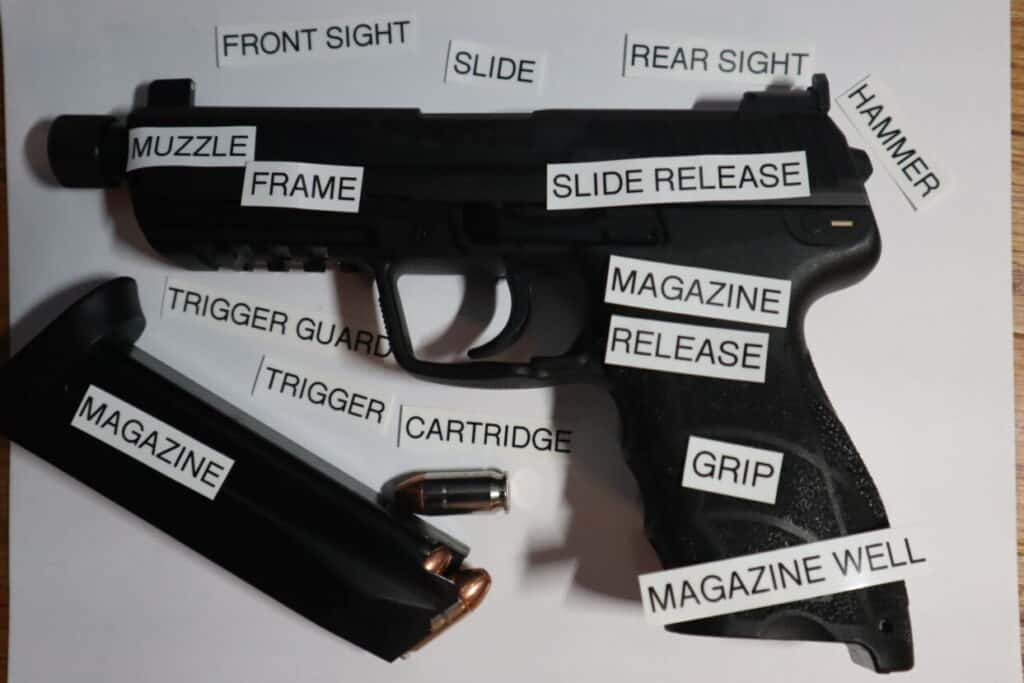
Muzzle
As with the revolver, the muzzle of the semi-auto is the end of the barrel that you point at the target. Looking down the barrel of a gun is something to avoid. Practice good muzzle control and never point it at anything you are not willing to destroy.
Frame
The frame is what the slide mounts on. The magazine fits into the frame and the slide rides on top.
Slide
The slide is the part that holds the firing pin and the barrel. It cycles in a front to back motion when the gun is fired. The extractor in the slide pulls out the empty case you just shot, then strips the next round out of the magazine and loads it into the chamber.
After you load a magazine into an empty semi-automatic, you rack the slide by pulling it backward. When you release the slide it moves forward to seat the first round.
Slide Release
When the slide is locked all the way back, the slide release unlocks the slide and lets it go forward. On most semi-automatics, when you shoot the last round, the slide locks back to let you know that you have shot the last round.
Magazine
The magazine is the removable dispenser for the cartridges. When you hear that a gun holds 17 rounds plus one in the chamber, that means 17 cartridges are in the magazine and one additional bullet can be carried in position for shooting.
You can see this round when you do a press check by pulling the slide back a little. The FN FNS-9 and some other semi-automatics have a visual indicator to show that a round is in the chamber. The extractor on the FNS-9 protrudes slightly and shows a little red mark when the chamber is loaded.
Cartridge
With any gun, the cartridge is the case that contains the powder and the bullet.
Magazine Release
This little button can be hard to find. In the picture above it is integrated into the trigger guard. In the picture below it is directly behind the trigger guard. You may press in or pull a lever depending on the model of the gun.
Magazine Well
This is the hollow part of the handle where you insert the magazine. Once you have it in, tap the magazine to ensure proper placement.
Grip
This is the handle of the gun. You wrap your palm around the back part, called the backstrap, and then your thumb and fingers wrap around to the front.
Your trigger finger stays pointed alongside the barrel until it is time to pull the trigger. In two handed shooting you wrap your supporting hand around the shooting hand on the grip.
Make sure the web between your thumb and forefinger is as high up on the grip as you can get it without interfering with the action of the slide to avoid being pinched when the slide racks back during shooting.
Front and Rear Sights
As with the revolver, you look between the rear sights and line up the front sight with your target. Like revolvers, semi-automatics have upgraded sights available with brighter dots, larger posts, lights, and laser pointers.
Trigger Guard
As with the revolver, the semi-automatic encases the trigger in a big oval or circular cage to keep you from shooting the gun accidentally. Keep your finger out of the trigger until you are ready to shoot.
Trigger
The trigger on a semi-automatic works the same way as a revolver, as the final step in activating the action that shoots the gun.
Hammer
Like a revolver, the hammer fired semi-auto can be single or double action. With a round in the chamber, you can pull the trigger. Without a round in the chamber, you must rack the slide, which is the moving metal piece on top, to chamber a round before pulling the trigger.
Safety
The safety is not specific to hammer-fired or striker-fired semiautomatics. The HK45 pictured above does not have an external safety because the V7 trigger won’t fire until you pull it all the way back and you have to rack the slide to cock the hammer.
The FN FNS-9 pictured below does have a safety, which blocks the trigger from going all the way back when the lever is pushed up. In the firing position, with the lever down, the trigger is able to go all the way back.
Single Action Hammer Fired
With a single action semi-auto you must cock the hammer the first time you fire the gun, then the slide cocks the hammer as it chambers the next round.
The Bersa Thunder 380 Matte .380 ACP has an MSRP of $327.00. It has a capacity of 8 rounds plus one in the chamber, with a barrel length of 3.5″ and a weight of 20 ounces.
1911
A popular subset of single action hammer-fired semi-automatics is the 1911, originally designed by John Browning and manufactured by Colt. Now it designates a particular body type that gun enthusiasts tend to love or hate.
Usually chambered in .45ACP, popular examples include Rock Island Armory’s 1911. In the $250-$500 MSRP range, the Rock Island Armory M1911-A1 GI .45 ACP costs $499, with a 5″ barrel and a capacity of 8 rounds plus one in the chamber. This gun weighs 38 ounces.
In the $500-$750 range you can get a Browning 1911-380 chambered in .380 ACP. This gun is $699.99 with with a 3.625″ barrel and a capacity of 8 rounds plus one in the chamber. It weighs 16 ounces.
In the over $750 range the Sig Sauer 1911 Ultracompact .45 ACP retails for $1,119.00. It boasts a 3.3″ barrel and has a capacity of 7 rounds plus one in the chamber. It weighs 28 ounces.
Double Action/Single Action Hammer-Fired Semi-Automatic
With a double actions/single action pistol, you choose whether to cock the hammer yourself or let the trigger cock the hammer for you. The difference is in the trigger pull weight.
Cocking the hammer yourself decreases the work involved in pulling the trigger, giving you the ability to shoot more rounds without getting tired and compromising your shooting form.
One such pistol is the Walther Arms P22 Target .22LR, with a 5″ barrel and a capacity of 10 rounds plus one in the chamber, and a weight of 20 ounces. It has an MSRP of $419.00
Beretta offers a 92X Compact 9mm for $700.00. With a capacity of 10 rounds plus one in the chamber, it has a barrel length of 4.3″ and weighs 27.2 ounces.
Sig Sauer makes the P226 Legion 9mm with a capacity of 15 rounds plus one in the chamber for an MSRP of $1.329.99 It weighs 34 ounces and has a barrel length of 4.4 inches.
Double Action Hammer Fired Semi-Automatic
For $749 you can get a Heckler and Koch P30 (V1) DAO 9mm with a capacity of 10 rounds plus one in the chamber. It weighs 26.08 ounces and has a 3.85″ barrel.
A double action semi-automatic does not require you to cock the hammer before you pull the trigger.
Striker-Fired Semi-automatic Pistol
The Anatomy of a Striker-Fired Semi-automatic Pistol
A striker fired semi-auto has an internal striker which takes the place of the hammer. You rack the slide to cock the striker. After the first shot the slide cocks the striker as it chambers the next round.
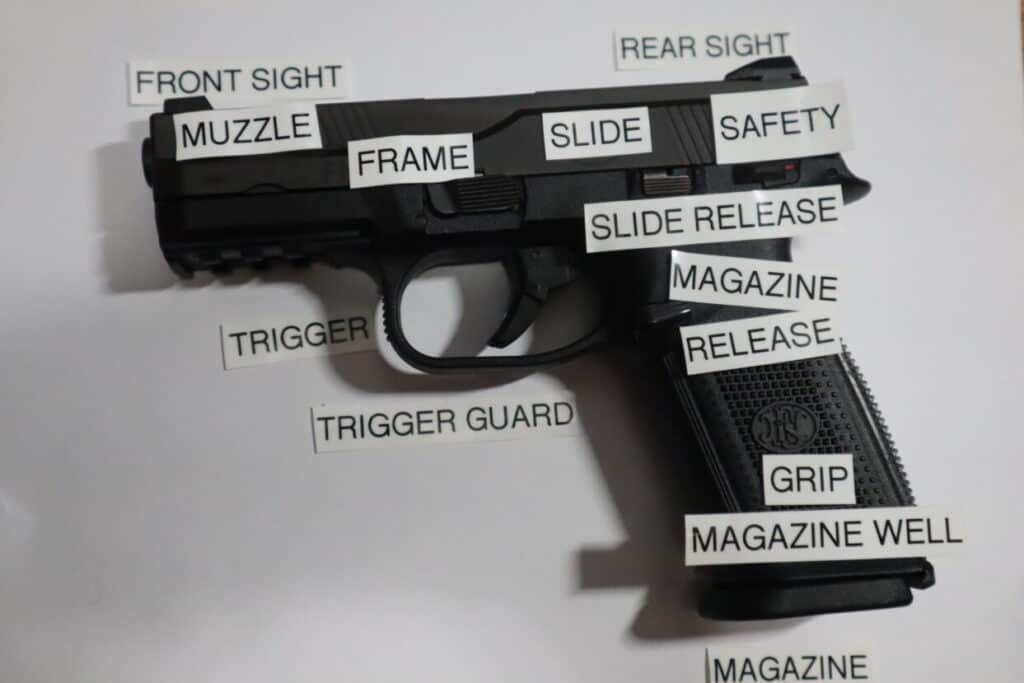
Most features are the same as the hammer-fired semi-automatic. The striker-fired does not have a hammer. In the photo below, the slide has been removed from a Sig Sauer P320. The striker is hidden under the rib in the middle of the slide.
The Diamondback Firearms DB9 9mm has an MSRP of $279.00. It has a barrel length of 3″ and a capacity of 6 rounds plus one in the chamber and weighs 11 ounces.
The FNS-9C 9mm has an MSRP of $639.00 With a barrel length of 3.6″ and a capacity of 12 rounds plus one in the chamber, it weighs 23.4 ounces.
The classic striker fired pistol is the Glock 19. For the Glock G19 G5 MOS 9mm the MSRP is $745.00. This gun has a 4.02″ barrel and a capacity of 10 rounds plus one in the chamber. It weighs 23.99 ounces.
Considerations in Choosing Your Gun
The decision to choose one type of gun over the other comes down to personal preference. When choosing which type of handgun is right for your needs, determine your most important factor.
Ease of Use
For me the most important factor is simplicity. I prefer a double action revolver because it has fewer moving parts and therefore is less likely to malfunction.
Concealability
My husband prefers a striker fired semi-automatic because it carries more rounds and is easier to conceal. Size definitely matters with concealment, and the revolver’s shapely lines are more difficult to conceal than the straighter lines of the semi-automatic.
Reliability
Modern guns are reliable in general, but the revolver is less likely to malfunction because it has fewer moving parts
Hand Size
My hands have no problem with a snub nose revolver. My husband needs more real estate because he does not have room to fit his pinkie on the grip of a small gun.
Hand Strength
I can rack a slide if I have to, but I struggle with locking the slide back on a stiffer gun such as the FN FNS-9. Trigger pull weight is another consideration. Single action guns will have a lighter pull weight because the hammer is already cocked.
The smaller revolvers can have a heavy trigger pull, so be sure to try shooting what you are thinking of buying. The investment in range time with be made up quickly if you don’t buy a gun and then sell it again right away because it wasn’t easy to pull the trigger.
Price
The MSRP is the Manufacturer’s Suggested Retail Price. Most gun dealers won’t charge you the whole MSRP. They decide for themselves how much margin they need between the price they pay and your price.
There is also a Minimum Advertised Price (MAP). Dealers are not allowed to advertise for less but they may choose to sell for less.
You may be able to negotiate a better deal. The more expensive the gun, the more margin there is for the dealer. The margin pays for the time and effort the dealer puts into finding the gun and getting it into your hands.
Reliable guns can be had at all price points. Spending more money gets you a bigger gun, nicer finish, higher quality materials, and more years of use. If you can’t afford the nicer guns, start with something in your price range and trade up later.
Remember that you can buy used guns from pawn shops and individuals. Take the time to plan your gun purchase and watch the advertisements for sales.
Availability
In the midst of today’s political turmoil, guns and ammunition are becoming a way to reassure oneself that the Constitution still guarantees us our Second Amendment right to bear arms.
Popular models of guns are not easy to find. If you can’t find exactly what you want, pick something you think you will like. You can trade up later.
There is a run on guns in any situation that makes us think our rights are under attack, as they certainly are right now.
Legality
The rules change all the time, so check the laws in your state before you decide on a particular model of gun.
We suggest getting liability insurance when you buy a gun.
